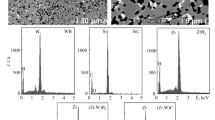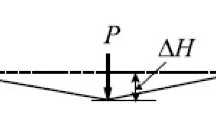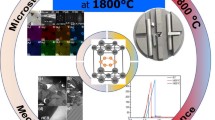Ultrahigh-temperature hafnium diboride ceramics with additions of 15 vol.% MoSi2 or 15 vol.% SiC or a combined addition of 15 vol.% SiC and 5 vol.% WC were produced by hot pressing in the range 1800–2000°C. The density of the produced composite ceramics was >98%. The components interacted in the hot pressing process to form new high-temperature phases (WB, MoB). The graine size of all structural elements did not exceed 5 μm. The maximum bending strength was reached by the HfB2–15 vol.% SiC–5 vol.% WC samples: 587 ± 25 MPa at room temperature and 535 ± 18 MPa at a test temperature of 1800°C, being associated with transcrystalline fracture of the ceramics. A three-layer oxide film formed: the upper layer was borosilicate glass with a HfSiO4 interlayer, the middle layer was HfO2 with B2O3–SiO2 inclusions, and the lower layer consisted of hafnium oxide and inclusions of other oxides. The total thickness of the oxide film was ~50 μm for the material oxidized at 1600°C for 5 h and ~150 μm at 1500°C for 50 h. The highest oxidation resistance was acquired by the HfB2–15 vol.% MoSi2 composite, where the oxidation rate did not exceed ~1 mg/cm2 ∙ h because a dense and homogeneous HfSiO4 layer developed on the surface. However, the most corrosion-resistant zirconium diboride composite, ZrB2–15 vol.% MoSi2, showed an oxidation rate of ~2 mg/cm2 ∙ h. This high oxidation resistance of the hafnium diboride ceramics is explained by slower oxygen diffusion in HfO2 and HfSiO4 than in ZrO2 and ZrSiO4, which is confirmed by mathematical modeling of the oxidation process.






Similar content being viewed by others
References
R. Savino, M. De Stefano Fumo, L. Silvestroni, and D. Sciti, “Arc-jet testing on HfB2 and HfC-based ultrahigh temperature ceramic materials,” J. Eur. Ceram. Soc., 28, 1899–1907 (2009), https://doi.org/10.1016/j.jeurceramsoc.2007.11.021.
P. Wang, H. Li, Y. Jia, Y. Zhang, and R. Yuan, “Ablation resistance of HfB2–SiC coating prepared by insitu reaction method for SiC coated C/C composites,” Ceram. Int., 43, 12005–12012 (2017), https://doi.org/10.1016/j.ceramint.2017.06.052.
P. Wang, S. Zhou, P. Hu, G. Chen, X. Zhang, and W. Han, “Ablation resistance of ZrB2–SiC/SiC coating prepared by pack cementation for graphite,” J. Alloys Compd., 682, 203–207 (2016), https://doi.org/10.1016/j.jallcom.2016.04.010.
J.S. Peters, B.A. Cook, J.L. Harringa, and A.M. Russell, “Erosion resistance of TiB2–ZrB2 composites,” Wear, 267, 136–143, 2009, https://doi.org/10.1016/j.wear.2009.01.037.
D.L. McClane, W.G. Fahrenholtz, and G.E. Hilmas, “Thermal properties of (Zr, TM)B2 solid solutions with TM = Ta, Mo, Re, V, and Cr,” J. Am. Ceram. Soc., 98, 637–644 (2015), https://doi.org/10.1111/jace.13341.
G.J.K. Harrington and G.E. Hilmas, “Thermal conductivity of ZrB2 and HfB2, ultra-high temperature ceramics materials,” Extrem. Environ. Appl., 9, 197–235 (2014), https://doi.org/10.1002/9781118700853.ch9.
W.B. Han, P. Hu, X.H. Zhang, J.C. Han, and S.H. Meng, “High-temperature oxidation at 1900°C of ZrB2–xSiC ultrahigh-temperature ceramic composites,” J. Am. Ceram. Soc., 91, 3328–3334 (2008), https://doi.org/10.1111/j.1551-2916.2008.02660.x.
O.N. Grigoriev, I.P. Neshpor, T.V. Mosina, V.B. Vinokurov, O.V. Koroteev, O.V. Buryachek, D.V. Vedel, A.M. Stepanchuk, and L. Silvestroni, “Behavior of high-temperature ZrB2-based ceramics in oxidation,” Powder Metall. Met. Ceram., 56, No. 9–10, 573–580 (2018).
L. Silvestroni, H.J. Kleebe, W.G. Fahrenholtz, and J. Watts, “Super-strong materials for temperatures exceeding 2000°C,” Sci. Rep., 7, 1–8 (2017), https://doi.org/10.1038/srep40730.
Y.H. Seong and D.K. Kim, “Oxidation behavior of ZrB2–xSiC composites at 1500°C under different oxygen partial pressures,” Ceram. Int., 40, 15303–15311 (2014), https://doi.org/10.1016/j.ceramint.2014.07.036.
L. Silvestroni, G. Meriggi, and D. Sciti, “Oxidation behavior of ZrB2 composites doped with various transition metal silicides,” Corros. Sci., 83, 281–291 (2014), https://doi.org/10.1016/j.corsci.2014.02.026.
D. Sciti, A. Balbo, and A. Bellosi, “Oxidation behavior of a pressureless sintered HfB2–MoSi2 composite,” J. Eur. Ceram. Soc., 29, 1809–1815 (2009), https://doi.org/10.1016/j.jeurceramsoc.2008.09.018.
G.L. Zhunkovskii, T.M. Evtushok, O.M. Grigoriev, V.A. Kotenko, and P.V. Mazur, “Activated sintering of refractory borides,” Powder Metall. Met. Ceram., 50, No. 3–4, 212 (2011), https://doi.org/10.1007/s11106-011-9320-2.
L. Kaufman, G. Cacciamani, M.L. Muolo, F. Valenza, and A. Passerone, “Wettability of HfB2 by molten Ni(B) alloys interpreted by CALPHAD methods. Part 1: Definition of the B–Hf–Ni system,” Calphad, 34, 2–5 (2010), https://doi.org/10.1016/j.calphad.2009.10.005.
O.M. Grigoriev, G.L. Znunkovskii, and D.V. Vedel, “Interaction of HfB2 with nickel and Ni–20% Cr alloy (nichrome),” Powder Metall. Met. Ceram., 58, No. 11–12, 671–678 (2020), https://doi.org/10.1007/s11106-020-00104-1.
G.V. Samsonov and I.M. Vinnitskii, Refractory Compounds: Handbook [in Russian], 2nd ed., Metallurgiya, Moscow (1976), p. 560.
R.A. Andrievskii and I.I. Spivak, Strength of Refractory Compounds and Associated Materials [in Russian], Metallurgiya, Chelyabinsk (1989), p. 368.
F. Monteverde, A. Bellosi, and L. Scatteia, “Processing and properties of ultra-high temperature ceramics for space applications,” Mater. Sci. Eng. A, 485, 415–421 (2008), https://doi.org/10.1016/j.msea.2007.08.054.
D. Sciti, L. Silvestroni, and M. Nygren, “Spark plasma sintering of Zr- and Hf-borides with decreasing amounts of MoSi2 as sintering aid,” J. Eur. Ceram. Soc., 28, 1287–1296 (2008), https://doi.org/10.1016/j.jeurceramsoc.2007.09.043.
E. Opila, S. Levine, and J. Lorincz, “Oxidation of ZrB2- and HfB2-based ultra-high temperature ceramics: Effect of Ta additions,” J. Mater. Sci., 39, 5969–5977 (2004), https://doi.org/10.1023/B:JMSC.0000041693.32531.d1.
F. Monteverde, C. Melandri, and S. Guicciardi, “Microstructure and mechanical properties of an HfB2 + 30 vol.% SiC composite consolidated by spark plasma sintering,” Mater. Chem. Phys., 100, 513–519 (2006), https://doi.org/10.1016/j.matchemphys.2006.02.003.
P.S. Sokolov, A.V. Arakcheev, I. L. Mikhal’chik, L.A. Plyasunkova, I.F. Georgiu, T.S. Frolova, R.A. Mironov, A.V. Lanin, A.O. Zabezhailov, I.Y. Kelina, and M.Y. Rusin, “Ultra-high-temperature ceramics based on HfB2–30% SiC: Production and basic properties,” Refract. Ind. Ceram., 58, 304–311 (2071), https://doi.org/10.1007/s11148-017-0101-4.
F. Monteverde and A. Bellosi, “The resistance to oxidation of an HfB2–SiC composite,” J. Eur. Ceram. Soc., 25, 1025–1031 (2005), https://doi.org/10.1016/j.jeurceramsoc.2004.05.009.
L. Silvestroni, N. Gilli, A. Migliori, D. Sciti, J. Watts, G.E. Hilmas, and W.G. Fahrenholtz, “A simple route to fabricate strong boride hierarchical composites for use at ultra-high temperature,” Compos. Part B Eng., 183, 1–22 (2020), https://doi.org/10.1016/j.compositesb.2019.107618.
D.V. Vedel, O.N. Grigoriev, P.V. Mazur, and A.E. Osipov, “Structure, strength, and oxidation resistance of ultrahigh-temperature ZrB2–SiC–WC ceramics,” Powder Metall. Met. Ceram., 60, No. 1–2, 60–68 (2021).
O.N. Grigoriev, A.V. Stepanenko, V.B. Vinokurov, I.P. Neshpor, T.V. Mosina, and L. Silvestroni, “ZrB2–SiC ceramics: Residual stresses and mechanical properties,” J. Eur. Ceram. Soc., 41, 4720–4727 (202), https://doi.org/10.1016/j.jeurceramsoc.2021.02.053.
D.W. Ni, J.X. Liu, and G.J. Zhang, “Pressureless sintering of HfB2–SiC ceramics doped with WC,” J. Eur. Ceram. Soc., 32, 3627–3635 (2012), https://doi.org/10.1016/j.jeurceramsoc.2012.05.001.
D.L. Hu, Q. Zheng, H. Gu, D.W. Ni, and G.J. Zhang, “Role of WC additive on reaction, solid-solution and densification in HfB2–SiC ceramics,” J. Eur. Ceram. Soc., 34, 611–619 (2014), https://doi.org/10.1016/j.jeurceramsoc.2013.10.007.
F. Monteverde, “The thermal stability in air of hot-pressed diboride matrix composites for uses at ultra-high temperatures,” Corros. Sci., 47, 2020–2033 (2005), https://doi.org/10.1016/j.corsci.2004.09.019.
F. Monteverde, A. Bellosi, and L. Scatteia, “Processing and properties of ultra-high temperature ceramics for space applications,” Mater. Sci. Eng. A, 485, 415–421 (2008), https://doi.org/10.1016/j.msea.2007.08.054.
P. Hu and Z. Wang, “Flexural strength and fracture behavior of ZrB2–SiC ultra-high temperature ceramic composites at 1800°C,” J. Eur. Ceram. Soc., 30, 1021–1026 (2010), https://doi.org/10.1016/j.jeurceramsoc.2009.09.029.
E. Zapata-Solvas, D.D. Jayaseelan, P.M. Brown, and W.E. Lee, “Effect of La2O3 addition on long-term oxidation kinetics of ZrB2–SiC and HfB2–SiC ultra-high temperature ceramics,” J. Eur. Ceram. Soc., 34, 3535–3548 (2014), https://doi.org/10.1016/j.jeurceramsoc.2014.06.004.
E. Zapata-Solvas, D.D. Jayaseelan, H.T. Lin, P. Brown, and W.E. Lee, “Mechanical properties of ZrB2- and HfB2-based ultra-high temperature ceramics fabricated by spark plasma sintering,” J. Eur. Ceram. Soc., 33, 1373–1386 (2013), https://doi.org/10.1016/j.jeurceramsoc.2012.12.009.
V. Guérineau, G. Vilmart, N. Dorval, and A. Julian-Jankowiak, “Comparison of ZrB2–SiC, HfB2–SiC and HfB2–SiC–Y2O3 oxidation mechanisms in air using LIF of B2O3(g),” Corros. Sci., 163, 101–110 (2020), https://doi.org/10.1016/j.corsci.2019.108278.
A.Y. Potanin, A.N. Astapov, Y.S. Pogozhev, S.I. Rupasov, N.V. Shvyndina, V.V. Klechkovskaya, E.A. Levashov, I.A. Timofeev, and A.N. Timofeev, “Oxidation of HfB2–SiC ceramics under static and dynamic conditions,” J. Eur. Ceram. Soc., 41, 34–47 (2021), https://doi.org/10.1016/j.jeurceramsoc.2021.09.018.
S. Ghadami, E. Taheri-Nassaj, H.R. Baharvandi, and F. Ghadami, “Effect of in situ SiC and MoSi2 phases on the oxidation behavior of HfB2-based composites,” Ceram. Int., 46, 20299–20305 (2020), https://doi.org/10.1016/j.ceramint.2020.05.116.
S.J. Lee, E.S. Kang, S.S. Baek, and D.K. Kim, “Reactive hot pressing and oxidation behavior of Hf-based ultra-high-temperature ceramics,” Surf. Rev. Lett., 17, 215–221 (2010), https://doi.org/10.1142/S0218625X10013886.
T.A. Parthasarathy, R.A. Rapp, M. Opeka, and R.J. Kerans, “A model for the oxidation of ZrB2, HfB2 and TiB2,” Acta Mater., 55, 5999–6010 (2007), https://doi.org/10.1016/j.actamat.2007.07.027.
J. Zou, V. Rubio, and J. Binner, “Thermoablative resistance of ZrB2–SiC–WC ceramics at 2400°C,” Acta Mater., 133, 293–302 (2017), https://doi.org/10.1016/j.actamat.2017.05.033.
O.N. Grigoriev, B.A. Galanov, V.A. Kotenko, S.M. Ivanov, A.V. Koroteev, and N.P. Brodnikovsky, “Mechanical properties of ZrB2–SiC (ZrSi2) ceramics,” J. Eur. Ceram. Soc., 30, 2173–2181 (2010), https://doi.org/10.1016/j.jeurceramsoc.2010.03.022.
Y.F. Zheng and B. Fu, “Estimation of oxygen diffusivity from anion porosity in minerals,” Geochem. J., 32, 71–89 (1998), https://doi.org/10.2343/geochemj.32.71.
N. Capron, P. Broqvist, and A. Pasquarello, “Migration of oxygen vacancy in HfO2 and across the HfO2/SiO2 interface: A first-principles investigation,” Appl. Phys. Lett., 91, 1202–1221 (2007), https://doi.org/10.1063/1.2807282.
J. Yang, M. Youssef, and B. Yildiz, “Oxygen self-diffusion mechanisms in monoclinic ZrO2 revealed and quantified by density functional theory, random walk analysis, and kinetic Monte Carlo calculations,” Phys. Rev. B, 97, 1–7 (2018), https://doi.org/10.1103/PhysRevB.97.024114.
A. Navrotsky and S.V. Ushakov, “Thermodynamics of oxide systems relevant to alternative gate dielectrics,” Mater. Fundam. Gate Dielectr., 32, 57–108 (2006), https://doi.org/10.1007/1-4020-3078-9_3.
B.D. Vasyliv, V.Ya. Podhurs’ka, O.P. Ostash, O.D. Vasyl’ev, and E.M. Brodnikovs’kyi, “Influence of reducing and oxidizing media on the physicomechanical properties of ScCeSZ–NiO and YSZ–NiO ceramics,” Mater. Sci., 49, 135–144 (2013), https://doi.org/10.1007/s11003-013-9593-3.
Author information
Authors and Affiliations
Corresponding author
Additional information
Translated from Poroshkova Metallurgiya, Vol. 60, Nos. 11–12 (542), pp. 41–55, 2021.
Rights and permissions
About this article
Cite this article
Vedel, D., Grigoriev, O., Mazur, P. et al. Ultrahigh-Temperature HfB2-Based Ceramics: Structure, High-Temperature Strength, and Oxidation Resistance. Powder Metall Met Ceram 60, 685–697 (2022). https://doi.org/10.1007/s11106-022-00280-2
Received:
Published:
Issue Date:
DOI: https://doi.org/10.1007/s11106-022-00280-2




